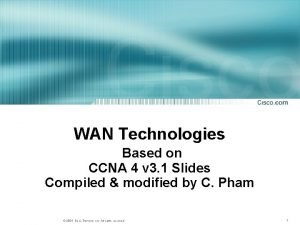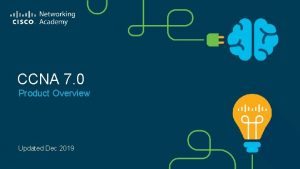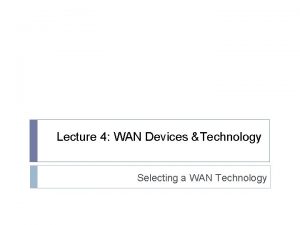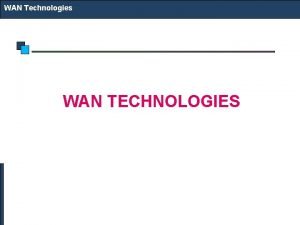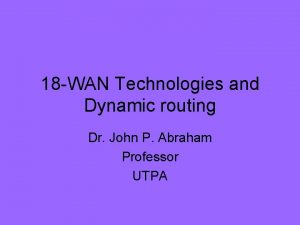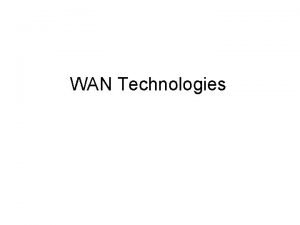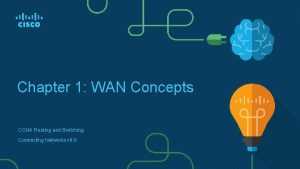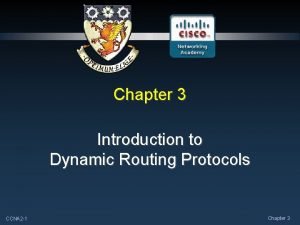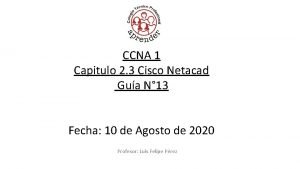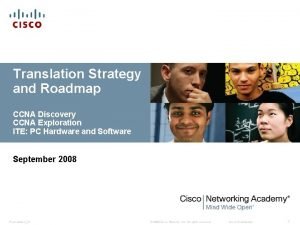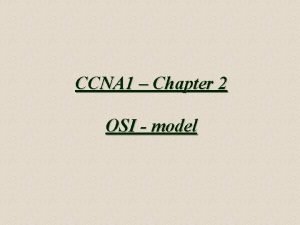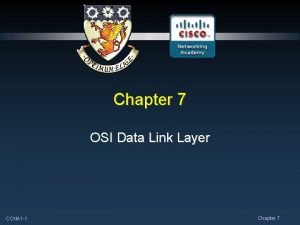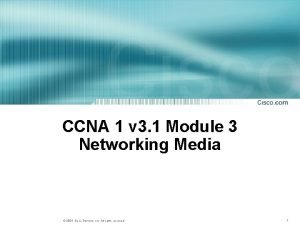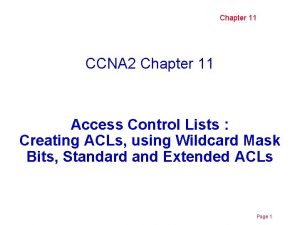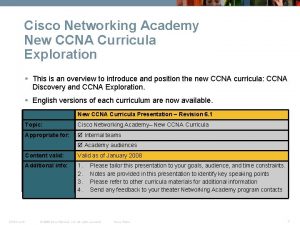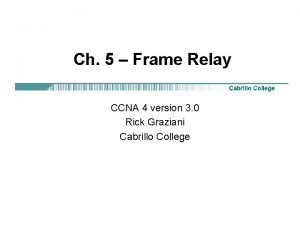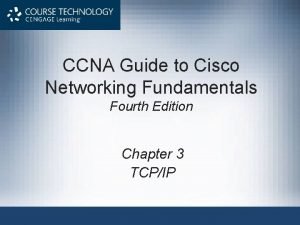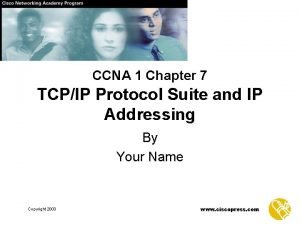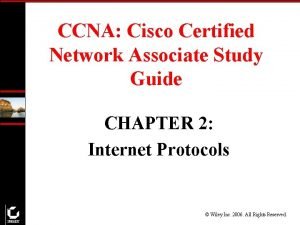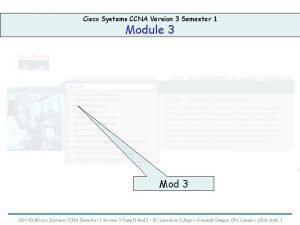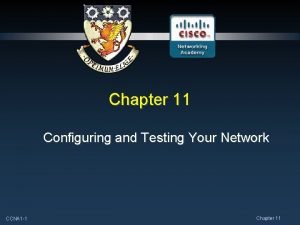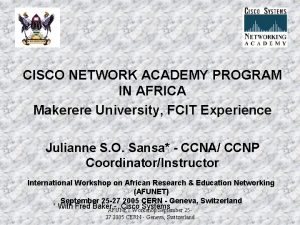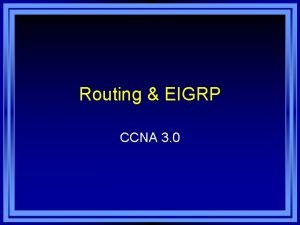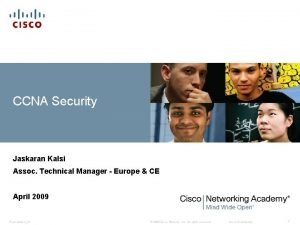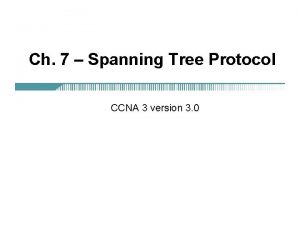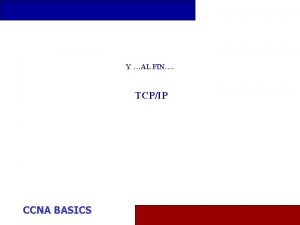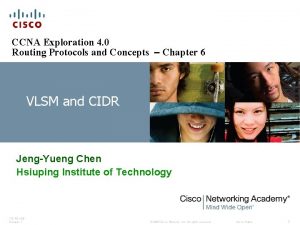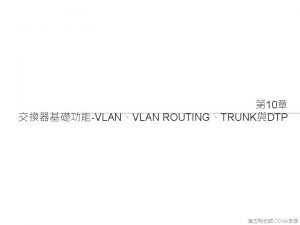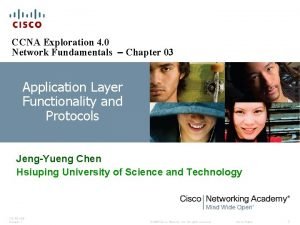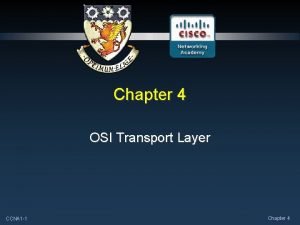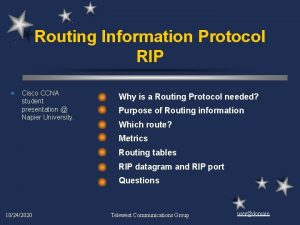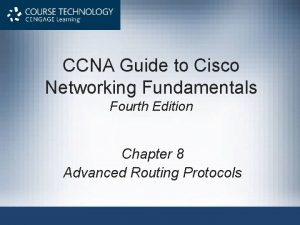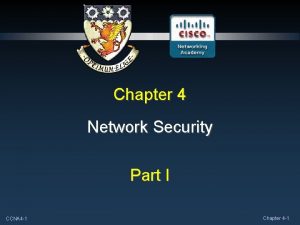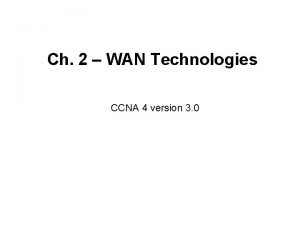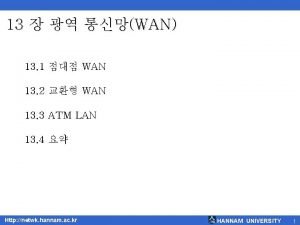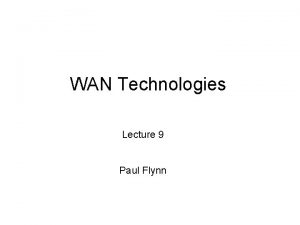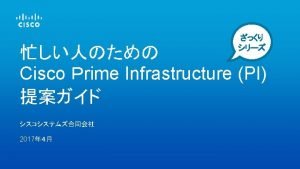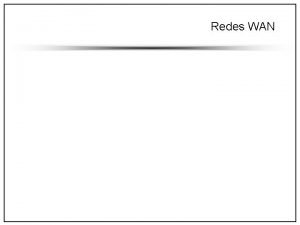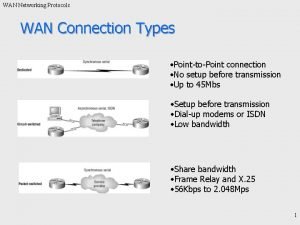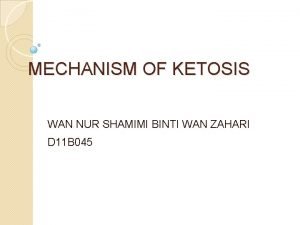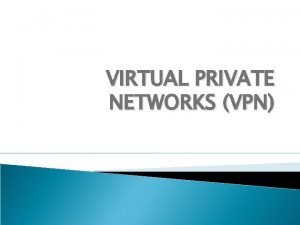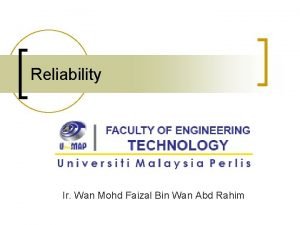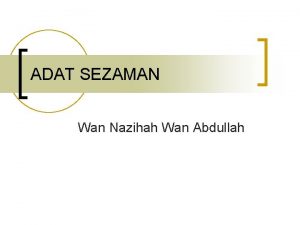Ch 2 WAN Technologies CCNA 4 version 3










































- Slides: 42

Ch. 2 – WAN Technologies CCNA 4 version 3. 0 Rick Graziani Cabrillo College

Note to instructors • If you have downloaded this presentation from the Cisco Networking Academy Community FTP Center, this may not be my latest version of this Power. Point. • For the latest Power. Points for all my CCNA, CCNP, and Wireless classes, please go to my web site: http: //www. cabrillo. cc. ca. us/~rgraziani/ • The username is cisco and the password is perlman for all of my materials. • If you have any questions on any of my materials or the curriculum, please feel free to email me at graziani@cabrillo. edu (I really don’t mind helping. ) Also, if you run across any typos or errors in my presentations, please let me know. • I will add “(Updated – date)” next to each presentation on my web site that has been updated since these have been uploaded to the FTP center. Thanks! Rick Graziani graziani@cabrillo. edu 2

Overview • • Note: Most of this will be described in more detail in later chapters. Differentiate between a LAN and WAN Identify the devices used in a WAN List WAN standards Describe WAN encapsulation Classify the various WAN link options Differentiate between packet-switched and circuit-switched WAN technologies • Compare and contrast current WAN technologies • Describe equipment involved in the implementation of various WAN services • Recommend a WAN service to an organization based on its needs • Describe DSL and cable modem connectivity basics • Describe a methodical procedure for designing WANs • Compare and contrast WAN topologies • Compare and contrast WAN design models • Rick Recommend a WAN design to an organization based on its needs Graziani graziani@cabrillo. edu 3

WAN technology/terminology • • Devices on the subscriber premises are called customer premises equipment (CPE). The subscriber owns the CPE or leases the CPE from the service provider. A copper or fiber cable connects the CPE to the service provider’s nearest exchange or central office (CO). This cabling is often called the local loop, or "last-mile". Rick Graziani graziani@cabrillo. edu 4

WAN technology/terminology • • A dialed call is connected locally to other local loops, or non-locally through a trunk to a primary center. It then goes to a sectional center and on to a regional or international carrier center as the call travels to its destination. Rick Graziani graziani@cabrillo. edu 5

WAN technology/terminology • • • Devices that put data on the local loop are called data circuitterminating equipment, or data communications equipment (DCE). The customer devices that pass the data to the DCE are called data terminal equipment (DTE). The DCE primarily provides an interface for the DTE into the communication link on the WAN cloud. Rick Graziani graziani@cabrillo. edu 6

WAN technology/terminology • • The DTE/DCE interface uses various physical layer protocols, such as High-Speed Serial Interface (HSSI) and V. 35. These protocols establish the codes and electrical parameters the devices use to communicate with each other. Rick Graziani graziani@cabrillo. edu 7

WAN technology/terminology • The bps values are generally full duplex. Rick Graziani graziani@cabrillo. edu 8

Name Abbr. Size Kilo K 2^10 = 1, 024 Mega M 2^20 = 1, 048, 576 Giga G 2^30 = 1, 073, 741, 824 Tera T 2^40 = 1, 099, 511, 627, 776 Peta P 2^50 = 1, 125, 899, 906, 842, 624 Exa E 2^60 = 1, 152, 921, 504, 606, 846, 976 Zetta Z 2^70 = 1, 180, 591, 620, 717, 411, 303, 424 Yotta Y 2^80 = 1, 208, 925, 819, 614, 629, 174, 706, 176 Rick Graziani graziani@cabrillo. edu 9

WAN Devices Frame Relay, ATM, X. 25 switch • Frame Relay, ATM, X. 25 switch Rick Graziani graziani@cabrillo. edu 10

External CSU/DSU To T 1 circuit • • To router For digital lines, a channel service unit (CSU) and a data service unit (DSU) are required. – We won’t go into the differences here. The two are often combined into a single piece of equipment, called the CSU/DSU. Rick Graziani graziani@cabrillo. edu 11

CSU/DSU Interface Card • The CSU/DSU may also be built into the interface card in the router. Rick Graziani graziani@cabrillo. edu 12

Modems • • Modems transmit data over voice-grade telephone lines by modulating and demodulating the signal. The digital signals are superimposed on an analog voice signal that is modulated for transmission. The modulated signal can be heard as a series of whistles by turning on the internal modem speaker. At the receiving end the analog signals are returned to their digital form, or demodulated. Rick Graziani graziani@cabrillo. edu 13

WAN Standards Organizations and • • WAN standards typically describe both physical layer delivery methods and data link layer requirements, including physical addressing, flow control, and encapsulation. WAN standards are defined and managed by a number of recognized authorities. Rick Graziani graziani@cabrillo. edu 14

Physical Layer Standards • Rick Graziani graziani@cabrillo. edu The physical layer protocols describe how to provide electrical, mechanical, operational, and functional connections to the services provided by a communications service provider. 15

WANs - Data Link Encapsulation • • • The data link layer protocols define how data is encapsulated for transmission to remote sites, and the mechanisms for transferring the resulting frames. A variety of different technologies are used, such as ISDN, Frame Relay or Asynchronous Transfer Mode (ATM). These protocols use the same basic framing mechanism, high-level data link control (HDLC), an ISO standard, or one of its sub-sets or variants. Rick Graziani graziani@cabrillo. edu 16

HDLC Framing • • • The choice of encapsulation protocols depends on the WAN technology and the equipment. Most framing is based on the HDLC standard. The address field is not needed for WAN links, which are almost always point-to-point. The address field is still present and may be one or two bytes long. Several data link protocols are used, including sub-sets and proprietary versions of HDLC. – Vendors usually use their own proprietary version of HDLC. Both PPP and the Cisco version of HDLC have an extra field in the header to identify the network layer protocol of the encapsulated data. Rick Graziani graziani@cabrillo. edu 17

WAN Link Options Rick Graziani graziani@cabrillo. edu 18

Circuit Switched POTS, ISDN • • When a subscriber makes a telephone call (or ISDN), the dialed number is used to set switches in the exchanges along the route of the call so that there is a continuous circuit from the originating caller to that of the called party. The internal path taken by the circuit between exchanges is shared by a number of conversations. Time division multiplexing (TDM) is used to give each conversation a share of the connection in turn. TDM assures that a fixed capacity connection is made available to the subscriber. Rick Graziani graziani@cabrillo. edu 19

Packet Switching Frame Relay, X. 25, ATM • • • An alternative is to allocate the capacity to the traffic only when it is needed, and share the available capacity between many users. With a circuit-switched connection, the data bits put on the circuit are automatically delivered to the far end because the circuit is already established. If the circuit is to be shared, there must be some mechanism to label the bits so that the system knows where to deliver them. It is difficult to label individual bits, therefore they are gathered into groups called cells, frames, or packets. The packet passes from exchange to exchange for delivery through the provider network. Networks that implement this system are called packet-switched networks. Rick Graziani graziani@cabrillo. edu 20

Packet Switching Frame Relay, X. 25, ATM • • • Packet-switched describes the type of network in which relatively small units of data called packets are routed through a network based on the destination address contained within each packet. Packet Switching allows the same data path to be shared among many users in the network. This type of communication between sender and receiver is known as connectionless (rather than dedicated). Most traffic over the Internet uses packet switching and the Internet is basically a connectionless network. (Search. Networking) Rick Graziani graziani@cabrillo. edu 21

Using Leased lines to the WAN Cloud • To connect to a packet-switched network, a subscriber needs a local loop to the nearest location where the provider makes the service available. • This is called the point-of-presence (POP) of the service. • Normally this will be a dedicated leased line. • This line will be much shorter than a leased line directly connected to the subscriber locations, and often carries several VCs. • Since it is likely that not all the VCs will require maximum demand simultaneously, the capacity of the leased line can be smaller than the individual VCs. Rick sum Graziani of graziani@cabrillo. edu 22

Analog Dialup • When intermittent, low-volume data transfers are needed, modems and analog dialed telephone lines provide low capacity and dedicated switched connections. Rick Graziani graziani@cabrillo. edu 23

ISDN • • • Integrated Services Digital Network (ISDN) turns the local loop into a TDM digital connection. – Usually requires a new circuit. The connection uses 64 kbps bearer channels (B) for carrying voice or data and a signaling, delta channel (D) for call set-up and other purposes. Never really became popular in the U. S. , known as It-Still-Does. Nothing or I-Still-Don’t Know Rick Graziani graziani@cabrillo. edu 24

Time Division Multiplexing (TDM) • • • Two or more “channels” of information are transmitted over the same link by allocating a different time interval for the transmission of each channel, i. e. the channels take turns to use the link. Some kind of periodic synchronizing signal or distinguishing identifier is required so that the receiver can tell which channel is which. TDM becomes inefficient when traffic is intermittent because the time slot is still allocated even when the channel has no data to transmit Rick Graziani graziani@cabrillo. edu 25

Leased Lines • • A point-to-point link provides a pre-established WAN communications path from the customer premises through the provider network to a remote destination. Point-to-point lines are usually leased from a carrier and are called leased lines. Leased lines are available in different capacities. Leased lines provide direct point-to-point connections between enterprise LANs and connect individual branches to a packet-switched network. Rick Graziani graziani@cabrillo. edu 26

X. 25 • • • The first of these packet-switched networks was standardized as the X. 25 group of protocols. X. 25 provides a low bit rate shared variable capacity that may be either switched or permanent. X. 25 is a network-layer protocol and subscribers are provided with a network address. Virtual circuits can be established through the network with call request packets to the target address. The resulting SVC is identified by a channel number. X. 25 technology is no longer widely available as a WAN technology in the US. Frame Relay has replaced X. 25 at many service provider locations. Rick Graziani graziani@cabrillo. edu 27

Frame Relay • • Frame Relay differs from X. 25 in several aspects. Most importantly, it is a much simpler protocol that works at the data link layer rather than the network layer. • Frame Relay implements no error or flow control. • The simplified handling of frames leads to reduced latency, and measures taken to avoid frame build-up at intermediate switches help reduce jitter. • Most Frame Relay connections are PVCs rather than SVCs. • Frame Relay provides permanent shared medium bandwidth connectivity that carries both voice and data traffic. Rick Graziani graziani@cabrillo. edu 28

ATM • • • Communications providers saw a need for a permanent shared network technology that offered very low latency and jitter at much higher bandwidths. Their solution was Asynchronous Transfer Mode (ATM). ATM has data rates beyond 155 Mbps. As with the other shared technologies, such as X. 25 and Frame Relay, diagrams for ATM WANs look the same. Rick Graziani graziani@cabrillo. edu 29

ATM • • • ATM is a technology that is capable of transferring voice, video, and data through private and public networks. It is built on a cell-based architecture rather than on a frame-based architecture. ATM cells are always a fixed length of 53 bytes. The 53 byte ATM cell contains a 5 byte ATM header followed by 48 bytes of ATM payload. Small, fixed-length cells are well suited for carrying voice and video traffic because this traffic is intolerant of delay. Video and voice traffic do not have to wait for a larger data packet to be transmitted. The 53 byte ATM cell is less efficient than the bigger frames and packets of Frame Relay and X. 25. Furthermore, the ATM cell has at least 5 bytes of overhead for each 48 -byte payload. A typical ATM line needs almost 20% greater bandwidth than Frame Relay to carry the same volume of network layer data. Rick Graziani graziani@cabrillo. edu 30

DSL • • • Digital Subscriber Line (DSL) technology is a broadband technology that uses existing twisted-pair telephone lines to transport high-bandwidth data to service subscribers. The term x. DSL covers a number of similar yet competing forms of DSL technologies. DSL technology allows the local loop line to be used for normal telephone voice connection and an always-on connection for instant network connectivity. The two basic types of DSL technologies are asymmetric (ADSL) and symmetric (SDSL). All forms of DSL service are categorized as ADSL or SDSL and there are several varieties of each type. Asymmetric service provides higher download or downstream bandwidth to the user than upload bandwidth. Symmetric service provides the same capacity in both directions. Rick Graziani graziani@cabrillo. edu 31

DSL english. speedxess. net • • Multiple DSL subscriber lines are multiplexed into a single, high capacity link by the use of a DSL Access Multiplexer (DSLAM) at the provider location. DSLAMs incorporate TDM technology to aggregate many subscriber lines into a less cumbersome single medium, generally a T 3/DS 3 connection techniques to achieve data rates up to 8. 192 Mbps. Rick Graziani graziani@cabrillo. edu 32

Cable Modem • • Coaxial cable is widely used in urban areas to distribute television signals. This allows for greater bandwidth than the conventional telephone local loop. Enhanced cable modems enable two-way, high-speed data transmissions using the same coaxial lines that transmit cable television. Some cable service providers are promising data speeds up to 6. 5 times that of T 1 leased lines. Rick Graziani graziani@cabrillo. edu 33

Cable Modem www. twcarolina. com • • Cable modems provide an always-on connection and a simple installation. A cable modem is capable of delivering up to 30 to 40 Mbps of data on one 6 MHz cable channel. With a cable modem, a subscriber can continue to receive cable television service while simultaneously receiving data to a personal computer. This is accomplished with the help of a simple one-to-two splitter. Rick Graziani graziani@cabrillo. edu 34

WAN Communication ? • WAN protocols operate at only the lower TWO layers of the OSI stack. Rick Graziani graziani@cabrillo. edu 35

WAN Topologies Star or Hub-and-Spoke Partial-Mesh Rick Graziani graziani@cabrillo. edu Full-Mesh >155 Mbps <45 Mbps 36

Three-layer design model (WAN version) Rick Graziani graziani@cabrillo. edu 37

Advantages of a Hierarchical Approach Rick Graziani graziani@cabrillo. edu 38

Another Three Layer Model Rick Graziani graziani@cabrillo. edu 39

WAN Considerations • • • Many enterprise WANs will have connections to the Internet. This provides an alternative for inter-branch connections. Since the Internet probably exists everywhere that the enterprise has LANs, there are two principal ways that this traffic can be carried. Each LAN can have a connection to its local ISP, or there can be a single connection from one of the core routers to an ISP. The advantage is that traffic is carried on the Internet rather than on the enterprise network, possibly leading to smaller WAN links. Rick Graziani graziani@cabrillo. edu 40

WAN Considerations • • • The disadvantage of permitting multiple links, is that the whole enterprise WAN is open to Internet-based attacks. It is also difficult to monitor and secure the many connection points. A single connection point is more easily monitored and secured, even though the enterprise WAN will be carrying some traffic that would otherwise have been carried on the Internet. Rick Graziani graziani@cabrillo. edu 41

Ch. 2 – WAN Technologies CCNA 4 version 3. 0 Rick Graziani Cabrillo College
 Wan technologies ccna
Wan technologies ccna Ccna 7
Ccna 7 What is a private wan
What is a private wan Leased line wan technology
Leased line wan technology Dr john wan
Dr john wan Wan devices
Wan devices Researching wan technologies
Researching wan technologies Wan link options
Wan link options Public wan technologies
Public wan technologies Routing protocols administrative distance
Routing protocols administrative distance Netacad ccna 1
Netacad ccna 1 Ccna exploration
Ccna exploration Osi model ccna
Osi model ccna Ccna 7 layers
Ccna 7 layers Ccna module 3
Ccna module 3 Ccna
Ccna Ccna 2 chapter 11
Ccna 2 chapter 11 Cisco ccna exploration
Cisco ccna exploration Ccna 200-301 slides
Ccna 200-301 slides Ccna voice 640-461 pdf
Ccna voice 640-461 pdf Frame relay ccna
Frame relay ccna Ccna guide to cisco networking
Ccna guide to cisco networking Ccna 1 chapter 7
Ccna 1 chapter 7 Ccna
Ccna Ccna
Ccna Sybex ccna
Sybex ccna Ccna chapter 11
Ccna chapter 11 Ccna makerere university
Ccna makerere university Auto summary in eigrp
Auto summary in eigrp Acl in ccna
Acl in ccna Ccna
Ccna Ccna
Ccna Automatic private ip addressing
Automatic private ip addressing Ccna exploration 4
Ccna exploration 4 Ccna vlan
Ccna vlan Intermediary devices
Intermediary devices Ccna exploration 4
Ccna exploration 4 Ccna module 3
Ccna module 3 Ccna 1 chapter 4
Ccna 1 chapter 4 Ripdates
Ripdates Ccna guide to cisco networking
Ccna guide to cisco networking Ccna 3 scaling networks ppt
Ccna 3 scaling networks ppt Ccna 4 chapter 4
Ccna 4 chapter 4
